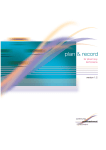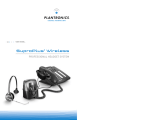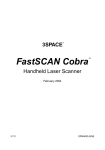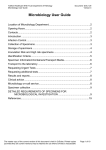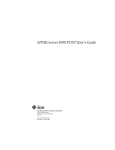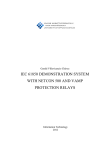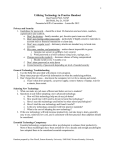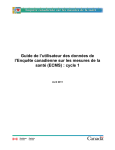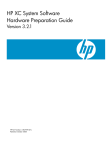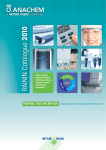Download Core Requirements draft 5th Edition
Transcript
NCSP Core Requirements 5th Edition Accompanying information The following text is referred to throughout the NCSP Core Requirements 5th Edition document and provides further detail / background information. August 2010 – amendments are in red text, and detailed on p.26 Core Requirements Section 2.3 - LCSSG membership and key responsibilities Local Chlamydia Screening Steering Group (LCSSG) The LCSSG should include representation from Commissioning General practice Community pharmacy Sexual and Reproductive Health (SRH) services Laboratories The Regional Facilitator Programmes are also advised to include representation from: PCT IT support or Information Management Public health Health promotion Communications Key roles and responsibilities of the LCSSG include: Have a named Programme Lead, with overall responsibility for the programme locally, and a named chair, who could be the Programme Lead or other appropriate senior representative. Hold minuted meetings at least quarterly. Develop and agree the local chlamydia testing plan. Monitor the performance of the local programme under the existing performance management framework of PCTs and SHAs, and using the NCSP targets, standards and guidelines. Monitor and implement solutions to QA problems highlighted by national or local QA procedures. Work collaboratively across the PCT/s in the programme area to develop and agree on costs for fully specified contracts between the lead purchaser and all local providers. Work collaboratively with the Regional Facilitator. Be aware of the financial position of the local programme and have a secure dedicated budget line. Assist the Programme Lead in identifying a base and staffing for the local chlamydia screening office. 1 Core Requirements Sections 2.4 and 2.5 - Roles of the Programme Lead and Coordinator Programme lead Key roles and responsibilities of the Programme Lead include: Chair the LCSSG. Guide delivery of the local programme, its constituent PCTs and the LCSSG, in compliance with the NCSP Core Requirements. Manage the allocated budget and arrange SLAs with participating PCTs. Ensure appropriate education and training for all NHS staff involved in the local programme. Act as the main point of contact for all media-related enquiries on the local programme. Oversee the QA arrangements and monitor performance indicators. Ensure that there are local protocols, care pathways and a testing plan Ensure that any serious incidents related to the chlamydia screening programme are reported to the NCSP within the agreed timescale Local Programme Coordination Local coordination of the screening programme can be allocated to one individual, or to a team responsible for the management of sexual health. Key roles and responsibilities include: Work with the Programme Lead and Regional Facilitator to ensure implementation and delivery of the local programme, in alignment with PCT accountability structures and as agreed by the LCSSG, in compliance with the NCSP Core Requirements. Compile, agree and monitor progress against the local testing plan. Performance manage all providers, giving regular feedback on screening rates against local and national targets. Embed the programme within local core services and identify where there is most potential to increase screening rates. Identify and work with local GP and pharmacy champions to increase screening and improve quality of services. Co-ordinate education and training for individuals involved in the local programme. Set up and liaise with screening sites, devolving treatment and PN, and other work such as making up screening packs, to other providers where feasible. Provide strong leadership and local championing of the screening programme at local, PCT, regional and SHA meetings, as needed. Keep up to date with national and regional health policy and plans. Develop, together with providers, local protocols, care pathways and a testing plan Agree pathways for the collation and submission of data. Ensure that core data and patient management and partner follow-up data are sent promptly to HPA. Ensure that data is collected for audits where required. Provide other activity reports as requested. Ensure that all screened people receive their results and treatment, and that a log is maintained of positives, partners and their management. Ensure provision of relevant patient group directions (PGDs). Coordinators with clinical registration for prescription or operation within PGDs may be involved with patient treatment and follow-up for those testing positive for infection where this can not be provided elsewhere. Identify unit costs and establish value for money solutions. Look for opportunities for joint procurement with other PCTs. Regularly evaluate screening initiatives in order to improve local performance and provide the outcome of evaluations to the NCSP. Oversee quality assurance of the local programme, ensuring that regular audits are carried out and that mechanisms are in place to ensure adequate management of results, treatment and partner notification. Use incident reports to improve the quality of care, working with providers to ensure that incidents are investigated and agreed actions taken, and share best practice where appropriate/possible 2 Core requirements Section 3.2 - Consent from young people under 16 The test initiator is responsible for ensuring that any young person under 16 being offered a test is competent to make an informed decision. Test venues must adhere to national and local guidance and ensure Fraser competency is assessed and documented. Fraser Guidelines establish that young people under 16 can give consent provided that the health professional is convinced that: The young person understands the health professional‘s advice, including risks The young person is aware that the health professional cannot inform the parents that s/he is seeking sexual health advice without consent, nor persuade the young person to inform the parents The young person is very likely to begin or continue having intercourse with or without contraceptive / sexual health treatment Unless s/he receives contraceptive advice or treatment the young person‘s physical or mental health or both are likely to suffer The young person‘s best interests require the health professional to give contraceptive advice, treatment or both without parental consent The Department of Health‘s Best practice guidance for doctors and other health professionals on the provision of advice and treatment to young people under 16 on contraception, sexual and reproductive health1 is available at: http://www.dh.gov.uk/prod_consum_dh/groups/dh_digitalassets/@dh/@en/documents/digitalasset/dh_ 081830.pdf See also GMC 0-18 Years: guidance for all doctors2: http://www.gmc-uk.org/guidance/ethical_guidance/children_guidance_index.asp 3 Core requirements Section 3.4 - Dual screening for Chlamydia and Gonorrhoea * The National Chlamydia Screening Programmes formal position statement on dual testing for chlamydia and gonorrhoea. (August 2010) There is limited evidence to support screening for gonorrhoea in unselected populations. Where individual programme areas are providing dual testing for chlamydia and gonorrhoea then information on both infections and consent for both tests must be obtained prior to screening. Where a sample is tested for gonorrhoea as part of a dual test for chlamydia and gonorrhoea the gonorrhoea result must be reported and acted upon. It is important that any additional activities do not negatively impact on the implementation and monitoring of the NCSP. The NCSP highlights the following implications of dual testing which should be considered by PCTs prior to the introduction of dual testing: o Evidence: There is no evidence to support widespread unselected screening for gonorrhoea, and evidence for selective community screening in UK settings is sparse (BASHH, Guidance for Gonorrhoea Testing). Commissioners are advised to consider the cost implications and localised prevalence rates before commencing a widespread screening programme. o Patient consent to use of data for monitoring the NCSP: Additional testing is not covered by the permissions sought and agreements made nationally for chlamydia testing o Patient information leaflet: The NCSP patient information leaflet does not cover any other test. Separate information will be required o Staff training: Knowledge of gonorrhoea, its treatment and implications for the young person must be disseminated to staff at appropriate levels of complexity o Lab Accreditation and standards: Labs providing dual testing should be CPA-accredited. Laboratories should not test for conditions that have not been specifically requested. o Treatment regimes and follow up recommendations will vary. Pathways should be reviewed to ensure that they are appropriate o Partner notification recommendations will vary and should be reviewed in the light of dual testing o Interpretation of results may be needed. E.g. in an area of low overall prevalence of gonorrhoea, positive results will require formal confirmation since the positive predictive value of a positive test could be low. Supplementary testing with a second NAAT using a different target is recommended for confirmation. Repeat testing of the residual NAAT is performed by many laboratories and is a reproducibility check for the testing process but not a confirmation. Test initiators should be prepared to explain test results and should have robust recall and retest protocols. Those with positive results should be referred to a level 2 or 3 service in accordance with the BASHH STI management guidance for culture for antibiotic sensitivity testing, treatment and partner notification. o Websites: where postal kits are sent out, it should be made clear on the website that the test will also be for gonorrhoea o Clinical risk for fail-safe for other infections needs to be delineated These are not exhaustive. The LCSSG is advised to take local and national advice from sexual health service providers before considering dual testing. Further information on gonorrhoea testing is available from BASSH, Guidance for Gonorrhoea Testing in England and Wales, 2010 *Please see Amendments on p.26 4 Core Requirements p12, section 3.6 - Detailed advice concerning specimen collection Testing may be undertaken using first-void urine samples (for men and women), self-taken vulvovaginal swabs, or cervical swabs if a speculum examination is being carried out as part of routine clinical care. The decision regarding which of these specimens to use will be made by the LCSSG in collaboration with the local clinicians and microbiologists participating in the programme. The following should be noted First-void urine is the sample of choice for men and for women who decline other sampling3,4 MSM should be offered the option of attending a venue competent to offer rectal chlamydia and gonorrhoea swabbing since there is a high rate of asymptomatic rectal infection in those practicing ano-receptive sex5. Care must be taken with all samples to avoid cross contamination. After collection, samples (including self taken samples obtained off site) should be placed in an individual specimen bag along with a completed request form. Information on collection, transport, storage and handling of specimens for both young people and staff should be provided. Information to allow women to make an informed choice regarding which type of sample should also be provided. Disposable equipment should be handled according to local infection control policy. Requirements for specimen collection Urine specimens (for men and women) Participants should be supplied with a labelled collection pot or kit and instructions. A suitable toilet and hand-washing facilities will need to be available and instructions given to allow participants to provide the urine sample. Example instructions for collecting a sample: 1. You should not have passed urine in the last hour. [Some platforms may require two hours.] If you have – please tell the person asking you to do this specimen BEFORE you do anything else. 2. Wash and dry your hands. 3. As soon as you start, pass the first part of your urine into the bottle (about half full). Pass the rest of your urine into the toilet. 4. If you have been given a grey ‗teabag‘-shaped pouch, insert it into the urine now. 5. Screw the cap back on tightly. 6. Ensure your name and number are on the specimen. 7. Place the specimen into the plastic specimen bag and hand it back to the clinic staff. If the young person is unable to pass urine, or has voided urine outside the manufacturers recommendations, they should be given specimen collection equipment and instructions, and asked to return another fresh sample as soon as possible. Women may also be offered a self taken vulvovaginal swab or offered an alternative sample type. Information regarding manufacturers recommendation, including specimen type (first void), quantity and time since last passed urine, should be adhered to. Additional information is needed for samples requiring the insertion of preservation pouches. Urine sample should be stabilised by refrigeration or by other means prior to transport to the lab (refer to manufacturers recommendations for sample stability). 5 Vulvovaginal swabs A private area with hand washing facilities will need to be made available for on site swabbing. Alternatively, after receiving instructions, specimens can be obtained off site and returned at a later stage. An appropriate sterile swab and instructions should be provided. Example instructions: 1. First, wash and dry your hands and then take the cotton wool swab out of the packing by twisting the cap. 2. Rub the soft cotton bud ends (not the plastic sticks) gently just inside the opening to your vagina. 3. Rotate the cotton buds, pressing firmly on the moist part inside. Please make sure they touch the skin inside your vagina. 4. Place the swab back into the small plastic tube. 5. Press the cap on tightly. 6. Ensure your name and number are on the tube. 7. Place the tube into the plastic specimen bag and hand it back to the clinic staff. Cervical specimens If a planned cervical examination is being undertaken, the opportunity should be taken for a cervical swab to be collected according to the manufacturer‘s recommendations. If a cervical examination is not being performed, participants should be offered the choice of a urine sample or self taken vulvovaginal swab. Cervical examination should not be carried out for the sole purpose of obtaining a specimen sample for testing. Specimen collection and transport These notes are for general guidance only and intend to set out what is in the test manufacturer‘s instructions. For further information please consult your local laboratory. However, please bear in mind: Several studies have shown that posted samples are suitable for testing even if transport time is up to one week6,7 Similarly, there is a great deal of evidence to suggest that vulvovaginal swabs are suitable samples9,8, although they are not validated by test manufacturers, with the exception of GenProbe APTIMA and Abbott RealTime. Note also the following: It is good practice to store all samples at +4oC, i.e. to refrigerate them between collection and transport to the laboratory. Ambient/room temperature is 15−27oC. Urine should be a first-catch sample. The appropriate sample collection kits, approved by test manufacturers, should always be used. 6 The tables below give further information. Gen-Probe SWABS URINE Roche Transport swab specimens to the laboratory in the swab specimen transport medium and tube. Must be transported at 2o to 30o and tested within 60 days. * For cobas 4800 see below Urine specimens can be transported to the laboratory at 2o to 30o in either the collection device or in the APTIMA urine specimen transport tube. NB Urine specimens must be transferred into the APTIMA urine specimen transport tube within 24 hours of collection and before testing. Once in the transport tube urine specimens can be stored at 2o to 30o for 30 days. Urine specimens must be collected in clean polypropylene containers which have no added preservatives. Samples can be transported at 15 - 30 C but must arrive in the laboratory within 24 hours of collection. Refrigerate until shipment to ensure that the time at 15 - 30 C does not exceed 24 hours and ship as soon as possible. Endocervical swabs must be collected and transported in M4RT medium (Remel). Samples may be transported at room temperature ie 15 - 30 C for testing within 14 days of collection Abbott Collections process identical for all swabs and urines with single collection device. Transport swab specimen using the multi-Collect Specimen Collection Kit. After collection, transport and store transport tube at 2°C to 30°C for up to 14 days or if longer storage is needed, store at -10°C or below for up to 90 days. Collections process identical for all swabs and urines with single collection device. Transport swab specimen using the multi-Collect Specimen Collection Kit. After collection, transport and store transport tube at 2°C to 30°C for up to 14 days or if longer storage is needed, store at 10°C or below for up to 90 days. * Cobas ® 4800 ―Swab and urine specimens collected with the cobas® PCR Female Swab Sample Kit and cobas® PCR Urine Sample Kit, respectively, can be transported at room temperature (15-30°C). Swab and urine specimens collected with the cobas® PCR Female Swab Sample Kit and cobas® PCR Urine Sample Kit, respectively, may be stored at 2-30ºC for up to 90 days once the specimen has been stabilized in the cobas® PCR Media. Urine specimens must be transferred into the cobas® PCR Media tube (stabilized) immediately. If specimens cannot be transferred immediately, they can be stored at 2 to 30°C for up to 24 hours 7 BD Viper XTR SWAB URINE BD Probetec The endocervical and the male urethral swab specimens must be stored and transported to the laboratory and/or test site within 30 days after collection if kept at 2 – 30ºC or within 180 days after collection if kept frozen at -20ºC. Patient-collected vaginal swab specimens must be stored and transported to the laboratory and/or test site within 14 days after collection if kept at 2 – 30ºC or within 180 days after collection if kept frozen at 20ºC. Patient collected vaginal swab specimens that are expressed in CT/GC Qx Swab Diluent may be stored and processed within 30 days after expression if kept at 2 – 30ºC or within 180 days after the date of expression if kept frozen at -20°C. Urine should be collected in sterile, plastic, preservative-free containers and can be transported either neat or using the BD Urine Preservative Transport (UPT) Qx see table below for further details. Endocervical/ urethral swabs must be stored and transported to the laboratory at 2-270C within 4-6 days. Urine should be collected in sterile, plastic, preservative-free containers and can be transported either neat or using the BD Urine Preservative Transport (UPT) see table below for further details. URINE SAMPLES FOR BD Probetec ONLY Urine Specimen Type to be Processed NEAT UPT Urine stored at 230 C + transferred to UPT within 8 hours Temperature Condition for Transport to Test Site and Storage Process Specimen according to Instructions 2-30 C 2-8 C Up to 30 hours of collection Up to 7 days from date of collection - 20 C Up to 2 months from date of collection 2-30 C Up to 30 days after transfer to UPT Urine stored at 2-8 C transfer to UPT within 24 hours 2-30 C Up to 30 days from date of collection -20 C Up to 2 months after collection 8 URINE Samples for BD Viper XTR ONLY Urine Specimen Type to be Processed Urine Handling Options Prior To Transfer To Qx UPT Temperature Condition for Storage and Transport to Test Site Process and Test Specimen According to Instructions Qx UPT NEAT Store urine specimen at 2 – 30oc and transfer to qx upt within 8 h of collection or store urine specimen at 2 – 8oc and transfer to qx upt within 24 h of collection or Transfer to Qx UPT immediately 2-8oC 2-30oC Within 30 days after transfer to Qx UPT -20oC 2-8oC 2-30oC -20oC Within 180 days after transfer to Qx UPT Within 7 days of collection Within 30 h of collection Within 180 days of collection 9 Core Requirements Section 3.6 - Clinical FAQs on the timing of tests How many days should pass after unprotected sex before a chlamydia test is undertaken? The NCSP recommends: Test immediately Repeat the test in 3−5 weeks If the first test is positive it may be because the index person already has chlamydia or, in the case of the female, that the test is picking up chlamydia in the partner‘s semen. In the latter case, the test may revert to negative after a few days and then, if the woman develops chlamydia, it will change back to being positive; hence the recommendation to repeat the test in 3−5 weeks. How often can a test be repeated? It is advised not to repeat a test within five weeks after treatment of a positive result, or within six weeks if treated with azithromycin3. NAATs are very sensitive and may pick up chlamydial nucleic acids from non-viable organisms9,10. If a patient requesting a chlamydia test is currently taking antibiotics (for an unrelated infection), how many days should pass before a chlamydia test should be undertaken so that false negatives would not be a problem? If the antibiotic being used could also be used to treat chlamydia, then it is important to consider whether this index patient may have therefore been indirectly treated for chlamydia. However, the partner may still have the infection and, as they have not been treated, and so may re-infect the index case. Clinicians should consider discussing partner notification if appropriate. If the antibiotic is one that has no effect on chlamydia, then timing of the test does not matter. What advice should be given to a woman who requests a chlamydia test but indicates that her period started today? How many days (if any) should elapse before swabs are undertaken? When using NAATs this does not matter; there is no interference seen with blood (Gen-Probe Optima Combo 2 Assay (2009), available at http://www.gen-probe.com/pdfs/pi/501798RevA.pdf; BD guidance, available at http://www.bd.com/ds/technicalCenter/inserts/pkgInserts.asp#PF8 ). However, if a woman felt uncomfortable providing a lower vaginal or endocervical swab at this time, or if she was using a tampon (see below) a urine test could be used instead. Alternatively she could be advised to wait until after her period. What advice should be given on the use of tampons? A tampon may absorb chlamydia organisms and reduce the effectiveness of a lower vaginal swab. Clinicians are advised to use a urine test or an endocervical swab in this instance. 10 Core Requirements Section 4.1 - Laboratory requirements and checklist for contracting labs All specimens must be tested by commercially available NAATs, which comply with the In vitro Diagnostics Directive. From December 2003 all in vitro diagnostic devices are required to carry a CE mark. In addition: Only appropriately trained staff in laboratories with suitable accreditation should carry out testing (e.g. Clinical Pathology Accreditation (UK) Ltd: www.cpa-uk.co.uk). Laboratories must be enrolled in a nationally recognised quality assurance scheme. Samples should be stored at 20°C or below by the laboratory following initial testing. Data regarding specimen type, test platform used and test result must be collected. For positive results, tests will be repeated on the same sample to exclude false positives arising from laboratory administrative errors or from contamination during specimen processing11. The table below shows how results should be coded: Test result Code to be reported in HPA quarterly file Description Other possible descriptions used Positive 1 Initially reactive sample which is confirmed Negative 2 Negative sample Equivocal 3 Unconfirmed reactive sample initially Invalid test, unconfirmed reactive, unconfirmed positive Insufficient 4 Not enough present to test sample Unknown/leaked Inhibitory 5 Indeterminate Virology Standard Operating Procedure (VSOP 37) is available at: www.hpa-standardmethods.org.uk/documents/vsop/pdf/vsop37.pdf * Checklist for choosing a nucleic acid amplification test platform – removed * Laboratory requirements – removed *Please see Amendments on p.26 11 Core Requirements Section 5.4 - Legal framework for supply and administration of medicines used by NCSP and Patient Group Directions (PGDs) Treatment must be administered by either medical practitioners or other clinical staff legally covered to work under PGDs. Regardless of the treatment delivery method that local programme areas elect to use, they must comply with clinical governance standards. If PGDs are in use, there must be clear documentation of who is the authorising medical consultant. Special considerations will need to be put in place for practices that can prescribe but not administer therapy. An template of a PGD for the administration of azithromycin is available on the NCSP website http://www.chlamydiascreening.nhs.uk/ps/core/index.html. Types of licensed medicines The Medicines Act 1968 regulates the sale, supply and administration of all medicines. Medicines are categorised in three - Prescription-only medicines (POMs, which require a prescription to be written, usually by a doctor, dentist, nurse or other approved prescriber), Pharmacy (P) medicines (which can only be sold through a registered pharmacy under the personal supervision of a pharmacist, and General Sales List (GSL) medicines (which are deemed even safer than P medicines and can be sold in general shops as well as through pharmacies, albeit often in small quantities). Both GSL and P medicines can be known as Over the counter (OTC) medicines. For more information on the mechanisms available for the prescribing, supply and administration of medicines to support the development of new roles or service redesign, see Department of Health. Medicines Matter (2006)12 the PGD website (www.pgd.nhs.uk), which contains and signposts to a wide selection of resources, including examples of PGDs such as national templates for emergency care, and which is supported by the National Knowledge Service Patient-specific directions and patient group directions (PGDs) Patient-specific directions A patient-specific direction is the traditional written instruction, from a doctor, dentist or independent prescriber, for medicines to be supplied or administered to a named patient, for example an instruction on a ward drug chart or an instruction by a GP in medical notes for a practice nurse to administer an injection. The majority of medicines are still prescribed, supplied or administered through this process. As a patient-specific direction is individually tailored to the needs of a single patient, it should be used 12 in preference to a PGD wherever appropriate . Patient group directions A PGD is a written instruction for the supply or administration of a medicine (or medicines) to groups of patients who may not be individually identified before presenting for treatment. The supply and administration of medicines under PGDs should be reserved for the limited number of situations where this offers an advantage for patient care (without compromising patient safety). Use of PGDs is appropriate when: the medicines to be given, and the circumstances under which they should be given, can be clearly defined in the written direction, and there is a robust evidence base; there are ‗high volume‘ groups of patients who present for treatment; medicines are to be supplied and/or administered by one of the registered health professionals who are allowed to use PGDs. Where clear criteria are included within the PGD, the PGD can include a flexible dose range so that the healthcare professional can select the most appropriate dose for each patient. The majority of clinical care should be provided on an individual, patient-specific basis. A PGD should be drawn up locally by doctors, pharmacists or other health professionals and must meet certain legal criteria. Each PGD must be signed by a senior doctor or dentist, as appropriate, and by a senior pharmacist, both of whom should have been involved in developing the PGD. Additionally the PGD must be authorised by an appropriate body, usually a primary care trust (PCT) or NHS hospital trust for NHS services. Accountability for any PGD lies with the signatories to that PGD. 12 The employing organisations have a legal duty of care and are responsible for ensuring that the staff they employ are properly trained and competent, and that they undertake only those responsibilities specified in agreed job descriptions. A list must be kept within each organisation detailing the individuals who approved the PGD and the individuals named as competent to use specific PGDs. A designated senior person in each profession locally should be responsible for ensuring that only fully competent, qualified and trained professionals operate within PGDs. For a PGD to be implemented, the signatures of all professionals who will be working within the PGD must be obtained, as well as the signatures of those giving organisational approval. Professionals work under patient group directions (PGDs) as named individuals, and no delegation of the supply or administration of medicines is permissible. Non-registered staff cannot administer medicines using a PGD, and cannot train others to prescribe medicines. PGDs can only be used by the following registered healthcare professionals, acting as named individuals: nurses, midwives, health visitors, ambulance paramedics, optometrists, orthoptists, chiropodists, podiatrists, radiographers, physiotherapists, pharmacists, dieticians, occupational therapists, prosthetists and orthotists, and speech and language therapists. All professionals must act within their appropriate professional code of practice, and their own level of expertise and competence. The use of PGDs must also be consistent with appropriate professional 12 relationships and accountability . Supply Treatments should only be supplied pre-packaged (―patient-ready‖) in appropriately labelled packs. Pre-packaged treatments should be obtained from a licensed hospital or PCT pharmacy pre-packing unit. The packs must either be supplied against a valid individual prescription or PGD or be supplied by a practitioner who is accredited to work with/under a PGD. The exception to this is pharmacists, who will dispense treatment from bulk stock. This should be done in accordance with dispensing and labelling regulations (guidance is available from the Royal Pharmaceutical Society of Great Britain (www.rpsgb.org.uk), Medicines Act 1968, and Medicines and Healthcare Products Advisory Agency (www.mhra.gove.uk)). PGDs and the under-16s There is no specific legislation regarding use of PGDs in those aged under 16 years. It is up to the individual PCT or host PCT, if covering several PCTs, to ensure that the document includes the locally agreed policy for the management of under-16s. The signatories of the PGD will have ultimate responsibility for its use in this age group. Staff using the PGD in the under-16s must have received the appropriate training and be aware of local care pathways and the nominated person(s) responsible for child protection issues. Off-label use in PGDs A PGD can include an ‗off-label use‘ (using a licensed product for an unlicensed use) provided that 12 there is appropriate and robust (ideally national) evidence . As with any off-label use, adequate information needs to be made available the patient. Such off-label use occurs in chlamydia screening with the use of azithromycin in children and pregnant women. Azithromycin in children The summary of product characteristics (SPC) for the Pfizer product, Zithromax®, does not specify (as of March 2007) what a child is, but there is discussion regarding weight needing to be >45kg. Pfizer considers that persons aged 12 years or over have a sufficiently mature metabolic mechanism to deal with the stat dose, even if their weight is marginally under 45kg. Guidance from the US Centers for Disease Control and Prevention states that children over the age of 8 years, regardless of weight, can receive the adult stat dose. At present there is no definitive guidance from the National Chlamydia Screening Programme (NCSP) on this topic, and individual PCTs will need to agree locally what stance they wish to take on this and to document any associated decisions. 13 Azithromycin in pregnancy The safety of azithromycin in pregnancy and lactating mothers has not yet been fully assessed, although available data indicate that it is safe. The British National Formulary (BNF) recommends its use only if no alternative is available. WHO guidelines recommend a 1g stat dose in pregnancy. The alternative is erythromycin 500mg bd for 14 days. This drug has a significant side effect profile, and some individuals may find it unacceptable or be unable to tolerate the regime. The NCSP advises that clinicians follow the recommendations made by the British National Formulary (www.bnf.org.uk/bnf/) and the British Association for Sexual Health and HIV (BASHH)3. Note: The generic azithromycin produced by TEVA UK Ltd has a similar SPC to that of Pfizer‘s product regarding age, weight and pregnancy. Presentation of Azithromycin PCTs should be aware that azithromycin is available generically in both capsule and tablet presentations. When choosing the presentation PCTs should take into account o Market availability o Drug tariff price o Ease of administration. o The fact that manufacturing Summary of Product Characteristics (SPCs) vary between tablets and capsules, and consideration may need to be given to this during the patient consultation. Tablets are film-coated and unaffected by the in take of food, allowing individuals to take the treatment dose immediately at any time. Capsules, according to the manufacturing SPC, are affected by the intake of food and carry the recommendation to take on an empty stomach i.e. avoid food 1 hour before taking, or for 2 hours after taking. A literal interpretation could prevent some individuals from taking the treatment on site. This has multiple implications: Inability to verify treatment has been taken; risk of failure to take; treatment issued under PGD would become chargeable if taken away by person. This problem arises from the relatively low bioavailability of the drug in the plasma. Some clinicians have taken a pragmatic approach of giving the treatment immediately and requesting patients to avoid food for 2 hours after. Further information is available at http://www.tevauk.com/webroot/files/products/49/files/Azithromycin%20250mg&500mg%20tablets%200028 9_0584-5.pdf http://www.tevauk.com/webroot/files/products/818/files/Azithromycin%20250mg%20capsules%2010622_04 74.pdf 14 Core Requirements Section 5.5 - Information sharing between GUM and the NCSP The following statement, issued in September 2006, is a joint position statement by BASHH, SSHA and the NCSP. It clarifies the position regarding sharing of information between GUM and the different healthcare professionals within the NCSP. Purpose of statement To establish communication pathways between GUM and chlamydia screening programmes (CSPs), to enhance the care of people with chlamydia, and their partners, within a framework of confidentiality. Primarily, this will be for the purpose of confirming index patient or partner treatment. Discussions for advice on clinical management, or for referral of complicated cases to GUM, may also be covered by this statement. The information shared would be “for the purpose of the treatment of the patient and/or the prevention of the spread of the disease” and therefore complies with NHS and PCTs STD directions (2000). Information may also be shared for surveillance and agreed audit purposes. Statement Information that allows individuals to be managed effectively for genital chlamydial infections may be exchanged between health care teams* working in GUM and chlamydia screening programmes operating within the NCSP. Information may include confirmation of tests taken, results, treatment given and follow-up arrangements for a named individual. Information will be exchanged verbally where possible. Staff identities will be verified before information is exchanged. Information exchanged will be documented in the relevant patient record. (*Clinical staff and administrative staff working under their direction working in GUM, the chlamydia screening office or other clinical screening venues operating within the NCSP.) This statement does not cover communication with non-clinical screening sites. Refer also to: Department of Health. Guidance for Access To Health Records Requests. 201013. Data Protection Act 199814. NHS Trusts and Primary Care Trusts (Sexually Transmitted Diseases) Directions 200015. SSHA. The Manual for Sexual Health Advisers. London: SSHA, 200416. 15 Core Requirements Section 9.1 - NCSP data application and user manual The NCSP database currently runs as a Windows based application in the HPA. A need arose for enhancements to the system which included the creation of a new web based system. The web application was developed and launched in 2008 and provides the following core functionalities: Security – authentication of authorized users User account management Automatic generation of clinic codes Search, view and submit functions for Core data and Patient and Partner Notification and Management data The link to the web based application http://www.chlamydiascreening.nhs.uk/ps/data/it.html and user manual are available at: Core Requirements Section 9.1 – Future Datasets The NCSP is moving towards comprehensive reporting of all chlamydia testing data in England in 2011 to evaluate the impact that NCSP is having on the infection and to better understand the epidemiology. Reporting of data will be through a disaggregate lab data return on all chlamydia tests and all dual chlamydia and gonorrhoea tests in all settings including GUM. NCSP is in the process of putting forward a Data Set Change Notice application to the ISB for the Chlamydia Testing Activity Dataset (CTAD). Core Requirements Section 9.2 - Further information on the NCSP dataset The NCSP Core Dataset has Review of Central Returns (ROCR) and National Information Governance Board for Health and Social Care (NIGB) approval. All core data should be reported via the NCSP web based application in a comma-delimited file format (CSV). A sample template of the NCSP test request form can be found in Appendix 2. Core Requirements Section 9.3 - Non NCSP non GUM data All non NCSP non GUM data submitted should be accompanied by a completed questionnaire. Labs should report data on tests allocated to all PCTs and not restrict reporting to tests relating to PCTs who commission their services. Non NCSP non GUM data should not include tests reported on the NCSP form or tests done in GUM clinics. All non NCSP non GUM data should be reported via email to the NCSP Information Management team in the pre-specified format in an Excel; file. Core Requirements Section 9.4 - Patient Management and Partner follow up required data A sample of the Patient and Partner Notification and Management pro forma can be found in Appendix 3. 16 Core requirements Section 9.5 - Data management Maintaining high data quality, integrity, completeness and accuracy are all responsibilities of each local programme area. To help local programmes, we have developed a data quality questionnaire that each programme area should complete and send in with their core data on a quarterly basis. The aims of this questionnaire are to flag up to local programmes any issues that might compromise their data quality and significantly reduce the risk of areas submitting incorrect figures. A sample of this questionnaire can be found in Appendix 4. Core requirements Section 9.5 - Confidentiality Confidential data (i.e. clinic or NHS number, date of birth, and postcode) must not be disclosed to anyone other than the provider of the data, local programme staff handling the data and the NCSP. No data may be disclosed to any other parties unless in aggregate form and with the agreement of those responsible for their provision. Additional confidentiality measures include, but are not limited to the following: The full postcode will only be used to allocate tests into geographic areas by SHA, PCT, local authority and ward, after which it will be stripped from the file and kept in a separate password secured database. A unique identifier generated by the HPA will be used to link tests from the original database to the postcode specific one. While data are held locally, access to records should be restricted to the Programme Coordinator and colleagues who help with administration under supervision. Restriction of access to such users must form part of the system security. At no time should data be used for any purposes other than those for which they were specifically collected, unless the consent of the providers of that information has been confirmed. Enquires relating to confidential data should only be accepted by those people mentioned above. 17 Appendix 1: Technical specifications for the NCSP Core data in CSV (MS Access commadelimited export) format. Data item Description C1 Clinic ID code (unique ID number CLINICID for each participating setting) C2 Unique patient ID number (unique PATID ID code assigned to each patient) NHS number (unique ID code NHSID assigned by the NHS for all registered patients) Sex (the anatomic sex of the SEX patient, not their gender identity) or C3 C4 C5 C6 C7 Field name Date of birth (date of birth, as DOB reported by the patient) Postal code of residence POST Ethnicity (ethnic group based on ETHNIC ONS classification system, as reported by the patient) C7 Ethnicity (ethnic group based on (cont.) ONS classification system, as reported by the patient) Response categories and coding Format structure Justify Field length Record position A unique ID code for the setting, String assigned by HPA. NB: A web-based facility for CSOs to acquire setting codes is under development Any String Right 5−10 1−10 Right 10 11−20 Any Right 10 21−30 Left 1 31 Left 10 32−41 Left Left 8 2 42−49 50−51 Date Left 10 52−61 String Left 6 62−67 Numeric Left 1 68 Numeric Left 1 69 Numeric Left 1 70 1 2 0 Not 9 Not specified DD/MM/YYYY C9 C10 C11 C12 Date of attendance (date DOA specimen was collected from the patient) Reason(s) for test (why the REASTES patient is receiving a chlamydia T test) Male Numeric Female known Date Any String 1 White Numeric 11 White British 12 White Irish 13 Any other white background 8 Mixed 81 White and black Caribbean 82 White and black African 83 White and Asian 84 Any other mixed background 4 Black or black British 2 Black Caribbean 3 Black African 4 Any other black background 5 Asian or Asian British 51 Indian 52 Pakistani 53 Bangladeshi 54 Any other Asian background 7 Other ethnic group 6 7 Any other ethnic group C8 String Chinese 99 Unknown/not specified DD/MM/YYYY A03 Chlamydia screening A04 Diagnostic testing A08 Contact of chlamydia positive A11 Symptoms (A11 can be reported with either A03, A04 or A08) Specimen type (type of sample SPECTYP 1 Urine sample sent to the laboratory for testing) E 2 Cervical swab 3 Vulvovaginal swab 4 Urethral swab 5 Other New sex partner, last 3 months NEWSP 1 Yes (did the patient report a new 2 No sexual partner in the last 3 3 Unknown months?) 9 Patient declined to answer Two or more sexual partners in MULTSP 1 Yes last 12 months (did the patient 2 No report two or more sexual 3 Unknown partners in the last 9 Patient declined to answer 12 months?) 18 Data item C13 Description Field name Type of laboratory test (initial test TESTTYP used by laboratory to detect E chlamydia) Chlamydia test result (test result RESULT from the laboratory) C14 Response categories and coding Format structure 1 PCR4 Numeric 2 SDA 3 TMA 1 Positive Numeric 2 Negative 3 Equivocal 4 Insufficient specimen 5 Inhibitory result Justify Left Field length 1 Record position 71 Left 1 72 6 Culture Important notes on the data file: Items C1, C2 or C3, C4, C5, C8 and C14 must be completed for each test record submitted or else the record will be rejected and sent back to the source for correction. All other items should be completed in full; however, records will not be rejected if some fields are left blank. Additionally, for C7, C11 and C12, areas are encouraged to use the ‗unknown‘ response categories as appropriate rather than leave the field blank. 19 Appendix 2: National chlamydia test request form 20 Appendix 3: Patient and Partner Notification and Management pro forma LINE ITEM Description Data NCSPA1 NCSPA2 NCSPA3 NCSPA4 PATIENT MANAGEMENT INFORMATION ONLY (OPPORTUNISTIC SCREENING OF UNDER 25 YEAR OLDS outside GUM settings, NOT CONTACTS) Positive patients <25 years opportunistically screened (outside GUM settings) through the NCSP Total number of positives Total number of positive women Total number of positive men Total number of positives with unknown/unspecified sex A1 = A2 = A3 = A4 = NCSPB NCSPB1 NCSPB2 NCSPB3 NCSPB4 Positive patients <25 years with clinician-confirmed treatment Total number of positives treated Total number of positive women treated Total number of positive men treated Total number of positives with unknown/unspecified sex treated B1 = B2 = B3 = B4 = NCSPC NCSPC1 NCSPC2 NCSPC3 NCSPC4 Positive patients <25 years with patient-confirmed treatment Total number of positives treated Total number of positive women treated Total number of positive men treated Total number of positives with unknown/unspecified sex treated C1 = C2 = C3 = C4 = NCSPD NCSPD1 NCSPD2 NCSPD3 Treatment location for all positives Total number of positives treated at Genitourinary Medicine (GUM) Total number of positives treated at Chlamydia Screening Office (CSO) Total number of positives treated at family planning/contraception clinics (FP) Total number of positives treated at general practice (GP) Total number of positives treated at pharmacy Total number of positives treated at other locations/unknown locations NCSPA NCSPD4 NCSPD5 NCSPD6 D1 = D2 = D3 = D4 = D5 = D6 = CONTACT MANAGEMENT INFORMATION ONLY (OF POSITIVES FROM ABOVE) NCSPE NCSPE1 NCSPE2 NCSPE3 NCSPE4 NCSPF NCSPF1 NCSPF2 NCSPF3 NCSPF4 Partners reported by the positive patients reported above including untraceables Total number of partners reported by the positive patients from line A1 including untraceables. Total number of male partners reported by the positive patients from line A1 Total number of female partners reported by the positive patients from line A1 Total number of partners with unknown sex reported by positive patients from line A1 Number of partners reported by positive patients in A1 Total number of positives reporting only one partner Total number of positives reporting just two partners Total number of positives reporting just three partners Total number of positives reporting more than three partners E1 E2 E3 E4 = = F1 x 1 = F2 x 2 = F3 x 3 F4 *see guidance notes 21 NCSPH Contactable partners follow up NCSPH1 NCSPH2 NCSPH3 NCSPH4 NCSPH6 Total number of contactable partners known/believed informed Total number of partners known/believed informed by positives Total number of partners known/believed informed by clinical staff Total number of partners that attended on their own volition or contacted via other route Total number of partners that were not contacted (including untraceable partners) H1 = H2 = H3 = H4 = H6 = NCSPJ NCSPJ1 Partners known/believed tested Total number of partners known/believed tested J1 = NCSPM NCSPM1 NCSPM2 Treatment of partners Total number of partners with clinician confirmed treatment Total number of partners with treatment confirmed by index patient M1 = M2 = NCSPN NCSPN1 Treatment location for all partners Total number of partners known/believed treated at Genito-urinary Medicine (GUM) Total number of partners known/believed treated at Chlamydia Screening Office (CSO) Total number of partners known/believed treated at family planning/contraception clinics (FP) Total number of partners known/believed treated at general practice (GP) Total number of partners known/believed treated at pharmacy Total number of partners known/believed treated at other/unknown locations NCSPN2 NCSPN3 NCSPN4 NCSPN5 NCSPN6 N1 = N2 = N3 = N4 = N5 = N6 = 22 Appendix 4: Patient and Partner Notification and Management pro forma Centre for Infections Health Protection Agency 61 Colindale Avenue London NW9 5EQ www.hpa.org.uk www.chlamydiascreening.nhs.uk NCSP Core Data questionnaire Programme Area Name: _________________________________________ PCTs Covered: _________________________________________________ Data – Year: _____________________________ Data – Quarter: ___________________________ Date of data submission: _______________________ Contact name: ____________________________ Contact Number: ___________________________ Contact Email: ________________________________________________ Please read and answer these questions carefully. It is the responsibility of the local chlamydia screening programmes to ensure the quality of the datasets sent to HPA and that the datasets adher to the standards set by the HPA. 1. Have you experienced any serious IT related problems which in turn has affected your data quality in any way? YES NO Comments ………..……………… 2. Are you aware of any problems with your data entry at either the CSO or the laboratory? ………..……………… 3. Have you used either the patient‘s NHS number (if available) or assigned each patient a unique patient ID number as a unique identifier? ………..……………… 4. Have you either used your CSO or clinic‘s postcode as the patient postcode for any of your test records? If “Yes” please remove and leave the postcode field blank. 5. Have you double checked patients‘ dates of birth particularly obvious outliers (i.e. people aged under 15 years or those over 25 years) to ensure the accuracy of this information? 6. Have you identified and correctly followed up patients who are under 13 years and have been tested for chlamydia? ………..……………… ………..……………… ………..……………… 23 7. When re-importing files are you satisfied that the mandatory fields have remained UNCHANGED? Particularly fields such as programme area, clinic ID code, patient ID number or NHS number, date of birth, sex, date of specimen and specimen type. 8. Have you kept the patient‘s NHS number or patient ID Number UNCHANGED when re-importing files as this is crucial for de-duplication purposes? YES NO Comments ………..……………… ………..……………… 9. Have you locally double checked your data for discrepancies, inaccuracies and incompleteness? ………..……………… 10. If you have found any problems with your data, have you taken all the relevant steps to ensure that the error is corrected and data quality is maintained? ………..……………… 11. Locally are you satisfied with all the steps taken to ensure the integrity, accuracy and completeness of your data? ………..……………… 12. If you have had major issues with integrity, accuracy and completeness of your data: i. Who did you report these problems to at NCSP Data team? ii. What action was agreed? iii. Has this action been taken? ………………………………………………... ………………………………………………... ………………………………………………... General Comments: Data check carried out with: Name ……………………………………………… 24 References 1 Department of Health Best practice guidance for doctors and other health professionals on the provision of advice and treatment to young people under 16 on contraception, sexual and reproductive health. 2004 2 General Medical Council 0-18 Years: guidance for all doctors. 2007 3 BASHH Clinical Effectiveness Group. UK National Guideline for the Management of Genital Tract Infection with Chlamydia trachomatis. 2006. 4 BASHH Chlamydia Trachomatis Screening and Testing Draft Guidelines. 2010 5 Annan N T et al. Rectal chlamydia—a reservoir of undiagnosed infection in men who have sex with men. Sex Transm Infect 2009;85:176-179 6 Morré SA et al. Mailed, home-obtained urine specimens: a reliable screening approach for detecting asymptomatic Chlamydia trachomatis infections. Journal of Clinical Microbiology, 1999;37(4):976-980 7 Skidmore S, Horner P, Herring A, Sell J, Paul I, Thomas J et al. Vulvovaginal-swab or firstcatch urine specimen to detect Chlamydia trachomatis in women in a community setting? J.Clin.Microbiol. 2006;44:4389-94 8 Wiggins R, Graf S, Low N, Horner PJ. Real-time quantitative PCR to determine chlamydial load in men and women in a community setting. J.Clin.Microbiol. 2009;47:1824-9 9 Gaydos CA, Crotchfelt et al.Molecular amplification assays to detect chlamydial infections in urine specimens from high school female students and to monitor the persistence of chlamydial DNA after therapy. J. Infect Dis 1998:177;417-24. 10 Morre SA et al. Monitoring of Chlamydia trachomatis infections after antibiotic treatment using RNA detection by nucleic acid sequence based amplification J Clin Pathol: Mol Pathol 1998;51:149–154 11 Health Protection Agency Chlamydia trachomatis Infection – Testing by Nucleic Acid. Amplification Tests (NAATs).2008 12 Department of Health Medicines Matters 2006 13 Department of Health. Guidance for Access To Health Records Requests. London: Department of Health, 2010 14 Data Protection Act 1998. Available at: http://www.opsi.gov.uk/acts/acts1998/ukpga_19980029_en_1 15 NHS Trusts and Primary Care Trusts (Sexually Transmitted Diseases) Directions 2000. Department of Health 2000 16 Society of Sexual Health Advisors. The SSHA manual for sexual health advisors. 2004 25 Amendments August 2010: o The NCSP updated its guidance on dual testing, and published a position statement. This is now reproduced on p4 o Removal of Checklist for choosing a nucleic acid amplification test platform since all labs use NAATs o Removal of Laboratory requirements for NAATs since all labs use NAATs 26



























